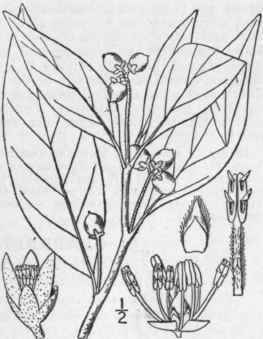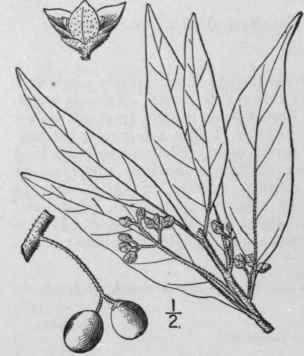Family 35. LaurÓceae Lindl. Nat. Syst. Ed. 2, 200. 1836. Laurel Family
Description
This section is from the book "An Illustrated Flora Of The Northern United States, Canada And The British Possessions Vol2", by Nathaniel Lord Britton, Addison Brown. Also available from Amazon: An Illustrated Flora of the Northern United States, Canada and the British Possessions. 3 Volume Set..
Family 35. LaurÓceae Lindl. Nat. Syst. Ed. 2, 200. 1836. Laurel Family
Aromatic trees and shrubs, with simple, alternate (very rarely opposite) mostly thick evergreen or deciduous, punctate exstipulate leaves. Flowers small, perfect, polygamous, dioecious, or sometimes monoecious, usually fragrant, yellow or greenish in panicles, corymbs, racemes or umbels. Calyx 4-6-parted, the segments imbricated in 2 series in the bud. Corolla none. Stamens inserted in 3 or 4 series of 3 on the calyx, distinct, some of them commonly imperfect or reduced to staminodia; anthers 2-celled or 4-celled, opening by valves. Ovary superior, free from the calyx, 1-celled; ovule solitary, anatropous, pendulous; style filiform or short, rarely almost wanting; stigma discoid or capitate. Fruit a 1-seeded drupe or berry. Endosperm of the seed none. Cotyledons plano-convex, accumbent.
About 40 genera and probably 1000 species, widely distributed in tropical regions; a few in the temperate zones.
Flowers perfect, panicled; leaves evergreen. | 1. | Persea. |
Flowers mostly dioecious, racemose or umbellate; leaves deciduous. | ||
Anthers 4-celled, 4-valved. | ||
Flowers in umbelled racemes; leaves, or some of them, lobed. | 2. | |
Flowers in capitate umbels; leaves all entire. | 3. | Glabraria. |
Anthers 2-celled, 2-valved; leaves entire. | 4. | Benzoin. |
1. P╔RSEA [Plum.] Gaertn. f. Fr. & Sem. 3: 222. 1805.
Trees or shrubs, with alternate coriaceous persistent entire leaves, and perfect panicled flowers. Calyx 6-parted, persistent, its segments equal or unequal. Stamens 12, in 4 series of 3, the inner series reduced to gland-like staminodia, the 3 other series anther-bearing, their anthers 4-celled, 4-valved, those of the third series extrorse and the others introrse in our species. Staminodia large, cordate, stalked. Fruit a globose or oblong berry. [Ancient name of some oriental tree.]
About 50 species, natives of America. Besides the following another occurs in Florida. Type species: Persea gratissima Gaertn. f. (Persea Persea (L.) Cockerell, the alligator-pear.)
Twigs and petioles puberulent or nearly glabrous. | 1. | P. Borbonia. |
Twigs and petioles densely tomentose. | 2. | P. pubescens. |
1. Persea Borb˛nia (L.) Spreng. Red Or Sweet Bay. Isabella-Wood
Fig. 1967
Laurus Borbonia L. Sp. Pl. 370. 1753. Persea Borbonia Spreng. Syst. 2: 268. 1825. Persea carolinensis Nees, Syst. 150. 1836. Notaphoebe Borbonia Pax in Engler & Prantl, Nat. Pflf. 3: Abt. 2, 116. 1889.
A tree, with dark red bark, reaching a maximum height of about 65o and a trunk diameter of 3°. Twigs puberulent or nearly glabrous. Leaves lanceolate, oblong or oblong-lanceolate, bright green above, paler beneath, glabrous when mature, 2-7' long, 1'-2' wide, obscurely pinnately veined, acute, acuminate or some of them obtuse at the apex, narrowed at the base; petioles 1/2'-1' long; peduncles short, axillary, often little longer than the petioles, bearing few-flowered panicles; calyx puberulent, spreading in fruit, its inner segments longer than the outer; berries dark blue, 1/2' in diameter or more, their pedicels thick, red.
Along streams and borders of swamps, Delaware to Florida and Texas, near the coast, north to Arkansas.
Wood hard, strong; color bright red; weight per cubic foot, 40 lbs. April-June. Fruit ripe Aug-Sept. False mahogany. Bay-galls. White bay. Tisswood.


2. Persea PubÚscens (Pursh) Sarg. Swamp Bay
Fig. 1968
Laurus carolinensis var. pubescens Pursh, Fl. Am.
Sept. 1814. Persea carolinensis var. palustris Chapm. Fl. S.
States, 393. 1860. Persea pubescens Sarg. Silva 7: 7 pl. 302. 1895.
A tree, seldom over 350 high, the trunk sometimes 15' in diameter. Bark brown; twigs densely brown-tomentose; leaves oval, oblong or lanceolate, glabrous and shining above when mature, pubescent beneath or also tomentose on the veins, acute, acuminate or obtuse at the apex, usually narrowed at the base, strongly pinnately veined, 3'-7' long, 1/2'-1 1/2' wide; petioles 4"-8" long; peduncles tomentose, mostly longer than the petioles, sometimes 2'-3' long; calyx tomentose, its inner segments longer than the outer; berry dark blue, 6"-9" in diameter.
In swamps and along streams, southern Virginia to Florida and Mississippi, near the coast. Great Bahama Island. Wood hard, orange-brown; weight per cubic foot, 40 lbs. May-July. Fruit ripe Sept.
Continue to:


